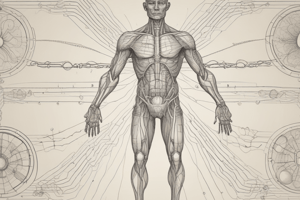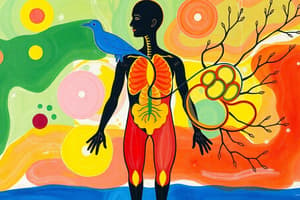Podcast
Questions and Answers
The thermoregulatory centre in the brain is called the ______.
The thermoregulatory centre in the brain is called the ______.
hypothalamus
When body temperature rises, blood vessels in the skin undergo ______ to allow heat loss.
When body temperature rises, blood vessels in the skin undergo ______ to allow heat loss.
vasodilation
The process of maintaining a steady body temperature is known as ______.
The process of maintaining a steady body temperature is known as ______.
thermoregulation
When your body is cold, blood vessels in the skin get narrower, a process called ______.
When your body is cold, blood vessels in the skin get narrower, a process called ______.
Sweating cools the body as the liquid sweat evaporates, which requires ______.
Sweating cools the body as the liquid sweat evaporates, which requires ______.
The process of keeping the internal environment within set ranges is called ______.
The process of keeping the internal environment within set ranges is called ______.
The ______ is involved in regulating body temperature and other homeostatic functions.
The ______ is involved in regulating body temperature and other homeostatic functions.
The ______ system helps deliver messages in the form of nerve impulses and hormones.
The ______ system helps deliver messages in the form of nerve impulses and hormones.
The organs that regulate blood glucose levels include the ______ and pancreas.
The organs that regulate blood glucose levels include the ______ and pancreas.
The skin and ______ work together to regulate body temperature.
The skin and ______ work together to regulate body temperature.
Flashcards
Homeostasis
Homeostasis
The process by which organisms maintain a stable internal environment despite changes in the external environment.
How does the body control homeostasis?
How does the body control homeostasis?
A sensor detects a change in the internal environment, sending a message to the control center (usually the brain).
Communication system in homeostasis
Communication system in homeostasis
The brain sends messages to target organs or tissues to correct the imbalance, via nerve impulses or hormones.
Target organ
Target organ
Signup and view all the flashcards
What factors are regulated in homeostasis?
What factors are regulated in homeostasis?
Signup and view all the flashcards
What is the hypothalamus's role in thermoregulation?
What is the hypothalamus's role in thermoregulation?
Signup and view all the flashcards
How does sweating help regulate body temperature?
How does sweating help regulate body temperature?
Signup and view all the flashcards
What is shivering and how does it work?
What is shivering and how does it work?
Signup and view all the flashcards
What is vasoconstriction and why does it occur?
What is vasoconstriction and why does it occur?
Signup and view all the flashcards
What is vasodilation and why does it occur?
What is vasodilation and why does it occur?
Signup and view all the flashcards
Study Notes
Homeostasis
- The body uses large amounts of energy to maintain a stable internal environment, even during sleep.
- This process is called homeostasis.
- Automatic control systems in the body maintain a constant temperature, water levels, and blood sugar.
- Homeostasis allows the body's cells to function optimally.
Homeostasis Definition
- Homeostasis is derived from two Greek words:
- "homeo," meaning unchanging, and
- "stasis," meaning standing.
- It's the process of maintaining a stable internal environment despite external changes.
- Homeostasis involves keeping the internal environment within specific ranges.
Control Systems in the Body
- Control systems maintain homeostasis.
- Sensors detect changes in the body.
- The control center, usually the brain, receives data from sensors and sends messages.
- The communication system, through nerves and hormones, carries messages to the target organs or tissues.
- Targets respond to the messages.
Organ Systems in Homeostasis
- Many organ systems contribute to homeostasis, not just one specific organ.
- Examples include skin, kidneys, liver, endocrine system, nervous system, and sensory system.
- They work together to maintain a stable internal environment.
- These systems maintain internal conditions within narrow limits.
- The hypothalamus plays a role in body regulation.
Factors Important for Cell Function
- Body cells operate best under specific conditions.
- Correct temperature
- Glucose concentration
- Water levels
Organs Involved in Homeostasis
- Water regulation: Kidneys regulate water and mineral salt concentration.
- Thermoregulation: Skin and muscles regulate body temperature.
- Glucose regulation: Liver and pancreas regulate blood glucose level.
Temperature Control
- Body temperature is controlled by temperature receptors in the skin and brain.
- The thermoregulatory center in the brain is called the hypothalamus.
- If body temperature deviates from 37°C, the hypothalamus and skin receptors trigger actions to adjust the temperature.
Sweating
- When the body is hot, sweat glands release sweat.
- Sweat evaporates, requiring heat, resulting in cooling.
- Heat loss through sweating regulates body temperature.
Shivering
- When the body is cold, the hypothalamus signals skin, muscular, respiratory, and circulatory systems.
- Blood vessels constrict to reduce heat loss.
- Muscles contract around pores causing shivering to produce heat.
- Thyroid releases hormones to increase metabolism and generate heat.
Vasoconstriction
- When core body temperature drops, blood vessels in the skin narrow (vasoconstriction).
- This reduces blood flow near the skin surface.
- Reduces heat loss. This is why people appear pale in cold temperatures.
Vasodilation
- When core body temperature rises, blood vessels in the skin widen (vasodilation).
- This increases blood flow near the skin's surface.
- Transfers heat to the environment for cooling. This is why people appear red when they are hot.
Blood Glucose
- Glucose is a type of sugar used by the body for energy.
- Blood glucose levels can vary.
- Eating raises blood glucose.
- Vigorous exercise lowers blood glucose.
- Homeostatic control:
- Excess glucose is converted to glycogen in the liver.
- Regulation by two pancreas hormones (insulin and glucagon).
- Hormones maintain glucose concentration.
Pancreas and Blood Glucose
- The pancreas monitors and controls blood glucose levels.
- Insulin is released when glucose levels are high, and the liver stores excess glucose as glycogen.
- Glucagon is released when glucose levels are low, and the liver converts stored glycogen into glucose.
Water Importance
- The human body is composed mostly of water.
- Water molecules and ions are essential for bodily functions.
- Dehydration damages cells.
Water Regulation
- The amount of water in blood must be regulated.
- Balance between water intake and loss is critical (drinking, food, respiration, sweating, urination).
- ADH (anti-diuretic hormone) regulates water reabsorption in kidneys.
Mechanisms that maintain homeostasis
- Negative Feedback mechanisms - response reverses the change.
- Positive Feedback mechanisms - response increases the change.
Examples of Negative Feedback
- Body temperature rises, skin blood vessels dilate, body temperature decreases.
- Body temperature drops, skin blood vessels constrict, body temperature increases.
Examples of Positive Feedback
- During childbirth, uterine contractions are stimulated by oxytocin, further stimulating oxytocin release until the baby is delivered.
Glossary of Terms Related to Homeostasis
- ADH: Hormone responsible for water balance regulation
- Dehydration: Water loss from the body.
- Homeostasis: Stable internal environment.
- Hyperthermia: Dangerously high body temperature.
- Hypothalamus: Brain part regulating various body functions.
- Hypothermia: Dangerously low body temperature.
- Glucose: Main source of body energy.
- Glucoregulation: Homeostasis control of blood sugar.
- Glycogen: Stored form of glucose.
- Insulin: Hormone controlling blood sugar levels.
- Kidneys: Filter blood and regulate water and mineral balance
- Negative feedback: Response reverses a change.
- Osmoregulation: Homeostatic control of body water and ion.
- Pancreas: Organ producing insulin and glucagon.
- Thermoregulation: Maintaining steady body temperature.
- Vasodilation: Blood vessel widening to release heat.
- Vasoconstriction: Blood vessel narrowing to conserve heat.
Studying That Suits You
Use AI to generate personalized quizzes and flashcards to suit your learning preferences.




